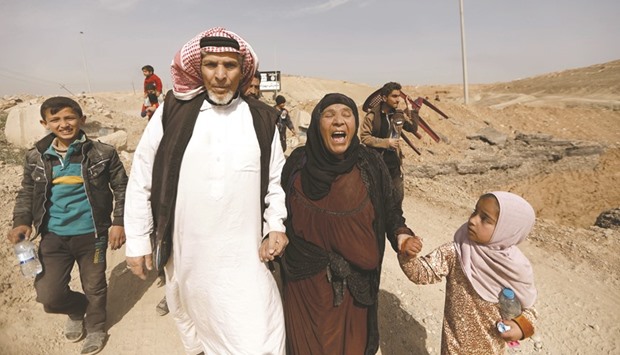Over 28,000 people have fled west Mosul since Iraqi forces launched a drive to retake it from militants, who put up “fierce” resistance in the city yesterday.
West Mosul is the largest population centre still controlled by the Islamic State group and its recapture would mark the effective end of the “caliphate” leader Abu Bakr al-Baghdadi announced from a mosque in the city more than two years ago.
Iraqi forces have yet to advance deep into west Mosul but fighting combined with privation and harsh IS rule has already pushed a growing number of civilians to flee.
“The humanitarian impact has been significant. Since the new offensive began, 28,400 people have been dispaced from west Mosul,” the United Nations office co-ordinating the Mosul humanitarian response said in a statement, citing International Organisation for Migration figures.
“Since February 25, approximately 4,000 people per day have been displaced,” it said.
The number who have fled is still only a fraction of the 750,000 people who are believed to have stayed on in west Mosul under IS rule but it is expected to rise sharply in the coming days and weeks.
A commander in the elite Counter-Terrorism Service said yesterday that IS put up tough resistance in the Maamun Flats area of southwest Mosul, which he said is considered “important for the control of the surrounding neighbourhoods”.
“The resistance is violent and fierce because they’re defending this line and this line, in our opinion, is the main line for them,” Staff Lieutenant General Abdulghani al-Assadi said.
Iraq’s Joint Operations Command announced later in the day that CTS had recaptured Maamun Flats.
The damage in the Maamun area is heavy, with homes destroyed, roads cratered and rows of crumpled cars, some of them piled one on top of another.
Fleeing residents have spoken of dire conditions inside the city.
“We’re so hungry, we haven’t eaten almost anything in four days,” said Widaa, a 20-year-old who fled Maamun.
“There was firing all around our house, it was being destroyed bit by bit,” she said.
The drive to retake west Mosul — the smaller but more densely populated side of a city split by the Tigris River — began on February 19, after Iraqi troops retook its east side the previous month.
Sniper fire is a significant danger in Maamun, said Kathy Bequary, the executive director of NYC Medics, a group providing emergency care from a mobile clinic.
“We’re seeing a lot of serious gunshot wounds from snipers,” Bequary said.
“Most of our patients are combatants, but civilians are affected too. Two days ago, we treated a family — a mother, father, son and daughter — who were trying to escape Mosul and were targeted by snipers,” she said.
“The five-year-old daughter was shot in the pelvis, a through and through wound. The girl was very, very critical.”
IS overran large areas north and west of Baghdad in 2014, announcing a “caliphate” incorporating swathes of Iraq and Syria. While security forces initially performed dismally, they have since retaken most of the territory they lost, with backing from US-led air strikes and other support.
IS has also lost significant ground in Syria, and while it still holds the city of Raqa in that country and some territory in western Iraq in addition to Mosul, the militants’ “state” is crumbling.
The operation to retake Mosul was launched on October 17, involving an array of sometimes rival security forces and paramilitary groups.
But the brunt of the fighting has fallen to the CTS and the interior ministry’s elite Rapid Response Division.

A displaced Iraqi woman reacts as she flees her home with her family while Iraqi forces battle with Islamic State militants, in western Mosul, yesterday.
